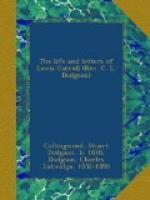Lewis Carroll.
The remainder of the year was uneventful; a few notes from his Diary must represent it here:—
Oct. 4th.—Called on Mr. Coventry Patmore (at Hastings), and was very kindly received by him, and stayed for afternoon tea and dinner. He showed me some interesting pictures, including a charming little drawing, by Holman Hunt, of one of his daughters when three years old. He gave me an interesting account of his going, by Tennyson’s request, to his lodging to look for the MS. of “In Memoriam,” which he had left behind, and only finding it by insisting on going upstairs, in spite of the landlady’s opposition, to search for it. Also he told me the story (I think I have heard it before) of what Wordsworth told his friends as the “one joke” of his life, in answer to a passing carter who asked if he had seen his wife. “My good friend, I didn’t even know you had a wife!” He seems a very hale and vigorous old man for nearly seventy, which I think he gave as his age in writing to me.
Oct. 31st.—This morning, thinking over the problem of finding two squares whose sum is a square, I chanced on a theorem (which seems true, though I cannot prove it), that if x squared + y squared be even, its half is the sum of two squares. A kindred theorem, that 2(x squared + y squared) is always the sum of two squares, also seems true and unprovable.
Nov. 5th.—I have now proved the above two theorems. Another pretty deduction from the theory of square numbers is, that any number whose square is the sum of two squares, is itself the sum of two squares.
I have already mentioned Mr. Dodgson’s habit of thinking out problems at night. Often new ideas would occur to him during hours of sleeplessness, and he had long wanted to hear of or invent some easy method of taking notes in the dark. At first he tried writing within oblongs cut out of cardboard, but the result was apt to be illegible. In 1891 he conceived the device of having a series of squares cut out in card, and inventing an alphabet, of which each letter was made of lines, which could be written along the edges of the squares, and dots, which could be marked at the corners. The thing worked well, and he named it the “Typhlograph,” but, at the suggestion of one of his brother-students, this was subsequently changed into “Nyctograph.”
He spent the Long Vacation at Eastbourne, attending service every Sunday at Christ Church, according to his usual rule.
Sept. 6, 1891.—At the evening service at Christ Church a curious thing happened, suggestive of telepathy. Before giving out the second hymn the curate read out some notices. Meanwhile I took my hymn-book, and said to myself (I have no idea why), “It will be hymn 416,” and I turned to it. It was not one I recognised as having ever heard; and, on looking at it, I said, “It is very prosaic;




